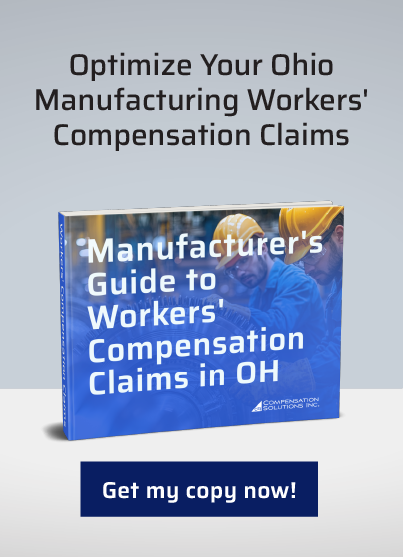How to Make Managing Medical Claims for OH Manufacturers Easy

In 2023, private employers in Ohio reported 84,800 workplace injuries and illnesses. In the manufacturing sector, the reported incident rate was nearly three for every 100 full-time workers, which means multiple medical claims.
The burden of managing these claims falls to HR offices that are already tasked with recruiting, onboarding, administering benefits, and dealing with multiple workplace personnel issues. Navigating BWC’s policies, tracking claims throughout their life cycles, and staying up to date with the incentive and rebate programs can be overwhelming.
Fortunately, a third-party administrator (TPA), someone who works on behalf of your business as an advocate, can offer strategies and solutions to simplify medical claims management, reducing the burden on your HR personnel and ensuring that your employees’ claims are processed efficiently. This way, you can manage risk and take advantage of premium reduction programs.
What Is an Employer’s Responsibility When an Employee Suffers a Workplace Injury or Illness?
A workers’ compensation claim begins with an on-the-job injury or work-related illness and concludes with claim resolution. The steps in between and the length of time that it takes to resolve will vary depending on the complexity of the claim. Multiple parties may be involved: for example, the injured employee, the employer, medical providers, the company’s Managed Care Organization, the Ohio Industrial Commission, the BWC, a TPA, and in some cases, attorneys of the company and the employee.
Your first responsibility as an employer is to respond quickly to workplace injuries and ensure that an injured worker receives prompt medical treatment. Collect witness statements and document the facts of the incident—basically, what caused the accident? Accurate documentation is critical.
The employee, the employer, or the medical provider may file the workers’ comp claim. The BWC will investigate and within twenty-eight days of filing, will determine whether to deny or allow the claim. The employer can certify or reject the claim by attesting to its validity and accuracy. If your investigation of the incident finds that the claim is exaggerated or fraudulent, you may reject it.
A claim must meet four requirements to be valid: There must be an employer-employee relationship, the injury must be accidental in nature, the employee’s injury must have occurred in the course of employment, and the injury must have been caused by actions directly related to the employee's job.
To evaluate and process a claim, the BWC needs supporting medical reports, the employer’s incident report, and a description of the injured worker's job, including wages. Workplace injuries result in lost productivity, excessive paperwork, and a less-desirable work environment for your employees, so naturally, you want to reduce your company’s incident rate.
How to Proactively Reduce Incident Rates
The most effective way to reduce accidents and workplace injuries is to foster a culture of safety among your workers. Entry-level and veteran employees alike will benefit from regular training programs that help them understand their roles in creating a safe work environment.
OSHA and BWC offer training programs designed to strengthen your safety team’s effectiveness and reduce workplace hazards. Employees can access this training in person or online and earn certifications for validation.
Authorized OSHA Training Institute Education Centers are located across the country and have industry-specific training. The courses range in topic from general health and safety to specific concerns, such as machinery and machine guarding standards, along with warehousing and storage safety protocols.
Ohio employers and employees with active workers’ comp coverage may enroll, tuition free, in online and in-person safety courses through the BWC Learning Center. The robust schedule of self-guided e-courses and webinars addresses common workplace hazards, such as the prevention of musculoskeletal disorders and heat-related illnesses.
Beyond changing employee behavior to mitigate risks, employers can reduce injury incidents by adopting the principles of industrial hygiene in their facilities. This is the science of identifying, assessing, and controlling potential workplace dangers. For example, an industrial hygienist may survey a workplace and identify a particular chemical as a possible hazard. They will evaluate if any fumes or contact with the chemical is an acceptable or unacceptable hazard and then suggest ways to control it, such as requiring employees to use personal protective equipment.
Despite efforts to create a safe and healthy workplace, accidents can happen, and you will need to deal with workers’ compensation claims.
How a TPA Can Streamline Medical Claims Management
A TPA will bring specialized knowledge to your business. They will investigate, evaluate, and administer medical claims, reducing the workload for your HR department. BWC policies are continually updated, and keeping your people up to date can mean hours of training that may be better spent elsewhere. A good TPA will ensure that your organization adheres to current regulations and submits the required forms on time.
Additionally, a full-service TPA offers risk management consultation. They will work with your company’s environmental, health, and safety department to reduce incident rates and can identify BWC rebates and incentive programs that apply to your operation.
Why Choose Compensation Solutions, Inc. to Manage Medical Claims
Compensation Solutions, Inc. (CSI) is respected in the industry for its proven record of developing risk management and cost containment strategies for Ohio manufacturers. It specializes in Ohio workers' comp administration services, and its team of underwriters and claims managers has decades of combined experience and strong relationships with the Ohio BWC. CSI offers each client a dedicated claims manager consultant, so you will always have an advocate who knows your business and your needs, along with a contact person to address any questions or concerns.
Final Note
Workplace injuries are distressing, and your first concern must be the injured worker. Navigating Ohio BWC requirements and ensuring that claims are quickly processed can be a challenge. Having a skilled TPA on your side will streamline the process and lift the burden from your HR department. CSI has a proven record of helping Ohio manufacturers expedite claims and reduce costs by providing risk management services.
Managing workers' compensation claims in Ohio shouldn’t be a headache. Partner with CSI to take the hassle out of claims, lower costs, and stay compliant with Ohio BWC regulations. Focus on your business and employees, and let our seasoned experts guide you through the complexities of workers' comp. Contact us today to streamline the process and experience stress-free claims management!

